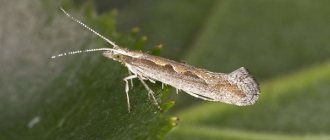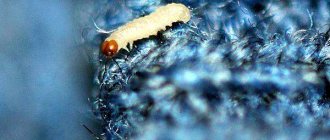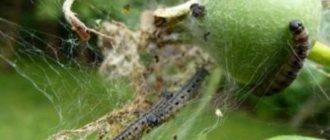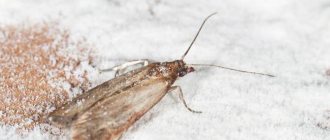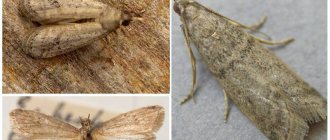Description of the pest
Wax moth (clump or moth), the most widespread and annoying pest of honey bees, belongs to the moth family, a species of moth-like butterflies. There are large moths with a wingspan of 18-35 mm and small (less common) with a wingspan of 16-24 mm, the color is ash-gray. The pest is found everywhere in areas of developed beekeeping.
Important! Knowing at what temperature the pest dies, you can fight successfully: wax moths die at high (+45°C and above) and low (0°C and below) temperatures in any phase of development.
The life cycle of a pest can be represented as follows:
- Eggs. An adult female can lay up to 1,500 eggs on frames in two weeks of life. The eggs are oval white, 0.35×0.5 mm, development period 5-8 days. Eggs laid in early summer develop into adult insects by autumn, and eggs laid in autumn overwinter in hives.
- Larva. The eggs hatch into small white larvae (1 mm). As the larva develops, its body changes to a darker color and it grows into a caterpillar.
- Caterpillar. The length of the caterpillar of the small wax moth is 13-16 mm, the large one is up to 18 mm, with a brown head and 8 pairs of legs. The caterpillar development cycle is 30 days. Each individual requires 1.5 g of wax to develop, so one caterpillar can destroy 500 or more cells, preferably from old dark honeycombs. Gnawing through the walls, they entangle the passages with cobwebs, which causes the death of the bees' brood. When the hive is heavily infested, cannibalism among the caterpillars is observed.
- Doll. After a month, the caterpillars turn into brown pupae, burrowing into secluded corners (cracks, cracks, folds, or gnawing holes). They pupate in cocoons arranged in groups. The length of the pupa of females is 16 mm, of males - 14 mm. The insect spends 9-14 days in the pupal state.
- Butterfly. Adult (imago) female butterflies live 7-12 days, male butterflies - 10-26 days. Butterflies have underdeveloped oral cavities and digestive tracts, so insects do not feed during this developmental phase. The wax moth flies from May to September, being nocturnal.
- In one year, 2-5 generations of pests grow. Only moth eggs and pupae overwinter.
Wax moth caterpillars feed mainly on wax and cause significant damage:
- honeycomb;
- bee brood;
- reserves of beebread and honey;
- frames;
- insulation of hives.
It is better not to store old and poorly built frames, but to melt the wax. The pest practically does not attack foundation and light frames. Honeycombs damaged by moths become unsuitable for storing beebread and honey, and bees are deprived of places for brood. With their excrement and waste, moths make the air in the hive unsuitable, and the bees leave the hive.
Did you know? Moth caterpillars can recycle plastic bags without harming their vital functions: in 6 hours, 50 caterpillars can eat 50 mg of plastic.
Strong bee colonies are able to cope with a pest invasion on their own. Working bees clean the cells, destroy the larvae, gnawing them out of damaged honeycombs, and do not allow adult insects into the hive. When a pupa is found, the bee seals it with propolis, and as a result the pupa dies.
But in some cases, human help is necessary, since with the onset of darkness the fires become more active and the bees stop fighting. Unlike bees, wasps do not produce wax. The building material for honeycombs is recycled wood fibers or clay. For this reason, the wax moth has nothing to feed on in the wasp's nest.
Oh moth
This tiny insect is capable of destroying about 2 g of wax in a month.
A completely unnoticeable amount, right? But no! Two grams of wax is about 600 processed honeycomb cells. When calculating damage, it is important to remember that there is more than one parasitic insect in the hive. One clutch can contain about 300 eggs. In 14 days of life, the female is capable of making about 5 clutches. Having made some simple calculations, it is clear why there is an urgent need to get rid of such a pest. An adult insect does not cause direct damage to bees, since it does not even have a mouthpart. She lives off previously accumulated reserves. Its main function and harm is laying eggs in the cracks of hives.
Important!
The moth loves dry heat and is most often found in regions located high above sea level.
Wax moth
The fight against wax moth should begin with studying information about it. Thus, two types of insects lay larvae in the hive: small and large. Their eggs can be found in litter at the bottom of the hive, in cracks in walls, in cells and in raw materials for wax. Three generations of moths can change in one season. The insect spends the winter in the pupal stage.
Over time, moth caterpillars emerge from the eggs. They make moves through the honeycomb in different directions, enveloping their path in a web. The web clogs the honeycomb, preventing the bees from storing the honey. These actions destroy the cells of the cell. Gradually, the honeycomb is destroyed, filling with cobwebs and caterpillar feces. The parasite's secretions pollute the air, forcing bees to leave their hive.
Interesting!
Strong, well-developed families are able to fight individual pests on their own. The worker bees simply tear the discovered “guest” into pieces. However, not every bee colony has the potential for this level of development.
Signs of wax moths
By carefully observing the behavior of the bee colony and the condition of the hives, you can quickly notice the invasion of wax moths:
- the flight of bees slows down, all the forces of the family go to fight the invaders;
- pests thrown out by bees are noticeable near the hives;
- bees appear with signs of cobwebs on their bodies;
- bees group at the entrance, but do not fly out;
- Moth butterflies are found in the apiary territory;
- Debris accumulates on the bottom, consisting of cobwebs, honeycomb particles, caterpillars and adult butterflies.
Did you know? It is assumed that bee moth enzymes can dissolve the wax-like membranes of the tuberculosis bacillus and fight Koch's bacillus.
Traditional methods against moths
Beekeeping is the most ancient craft of the national economy. You can use time-tested folk remedies at home:
- To repel moths, they are affected by strong odors. The following plants have this effect: peppermint, cold mint, oregano, wormwood, garlic, hops, nuts;
- They also use a mixture of the listed herbs with the addition of orange peels;
- Immortelle leaves, which are used to fumigate or cover infested frames, also have a deterrent effect.
Tincture - wax moth extract:
How to get rid of wax moths
Measures to combat wax moths and their larvae must be regular and comprehensive. At the first signs of infection in the hive and honeycomb storage, it is necessary to carry out treatment and further prevention, which consists of using the following methods:
- physical;
- chemical;
- biological;
- folk;
- fumigation with sulfur;
- temperature regime;
- salt treatment;
- treatment with acid vapors (acetic, formic).
Integrated pest control methods increase the effectiveness of activities.
Physical methods of struggle
The principle of physical control methods is to create uncomfortable conditions for the life of the pest - temperature and humidity:
- infected honeycombs are poured with boiling water - the wax may sag and become deformed, in which case it should be melted;
- temperature +45...+80°С - dry heat treatment of beekeeping equipment for 1-4 hours;
- temperature -7...-15°С - freezing frames for two days in the freezer. Frames with beebread cannot be frozen;
- low humidity when storing honeycombs (below 80%) - pests infest faster in a humid environment.
Chemical control methods
Chemical control methods should be used carefully and according to instructions.
It should be remembered that most drugs leave traces on honey and are just as dangerous for bees as they are for pests:
- “StopMol” (plates) - hung between frames, when weathered, replaced with new ones;
- treatment with methyl bromide gases (80 g/m³) or OKEBM (50 g/m³) during the day, carbon dioxide (concentration 95-98.5%);
- disinfection of honeycombs - formalin (50 g), carbon disulfide (150 ml) or paradichlorobenzene (50 g) - used to destroy eggs;
- spraying - "Biosafe" - a product destructive for caterpillars (30 ml per frame);
- spraying - "Entobacterin" against moths, "Dendrobacillin", "Insectin", "Thuringin" - these drugs are destructive to the pest, but do not harm beneficial insects;
- “Askomolin” - on top of hives with frames (10 tablets per frame);
- “Paradichlorobenzene” - the drug is placed between honeycombs (150-200 g/m³);
- “Timol” - double treatment after 5-10 days by applying to the upper bars (0.25 g per frame).
Important! When working with chemicals, it is necessary to use protective equipment (goggles, gown, gloves) to avoid contact with skin and mucous membranes. After handling, wash your hands thoroughly.
Traditional methods against moths
Traditional methods may not be as effective as chemical methods, but they are accessible to everyone and safe for honey bees. Folk remedies are based on the following methods of repelling and destroying pests.
The smell of plants
Moths cannot stand the smell:
- mint, lemon balm;
- hops and nut leaves;
- oregano;
- garlic;
- wormwood;
- elderberries;
- immortelle;
- marigolds;
- thyme;
- twigs of blackroot.
Using these plants together enhances the effect and leads to positive results. Herbs can be sown near the hives or dry mats can be placed in storage and throughout the hive. The moth cannot stand the smell of printing ink - fresh newspapers placed throughout the hives can also serve as a method of control.
Salt
The honeycombs freed from honey must be dried and sprayed with a strong salt solution on both sides. After drying, sweep away the excess salt layer. Moths do not grow in honeycombs treated with salt. In the spring, before installing in the hives, sprinkle the honeycombs with water. Such manipulations will provide the bee colony with the necessary salt.
Also learn how to control varroa mites in bees.
Vinegar
To disinfect and prevent infection, honeycombs are installed in empty hives or plastic sleeves, which are tightly and hermetically covered. A container or rag soaked in vinegar essence (200 g, 70%) is placed under the packaging. They are kept in such conditions for at least three days, and after 10-12 days the procedure is repeated. Unfortunately, the essence evaporates over time, and this method does not destroy moth eggs. Before installation in the hives, the honeycombs are ventilated.
Formic acid
Treat the hive with honeycombs twice with acid (14 ml), covering for 3-4 days at intervals of 10-12 days. When moths appear around the apiary area, you can make traps from honey water with the addition of bee bread and yeast. When flying at night, butterflies drown in traps and die. Baits are placed at night and removed in the morning.
Video: fighting wax moths
Fighting moths in the hive
Getting rid of wax moths is not easy, and the process itself is very unpleasant. Sometimes it can take several sessions. This happens if a lot of larvae have developed.
To prevent moths from getting into the hive, you need to periodically carry out preventive actions that will help you avoid infection with parasites. But, if this happens, then under no circumstances should you hesitate and you need to urgently start the fight.
You can fight wax moths in the following ways:
- biological;
- mechanical;
- chemical;
- folk.
Each method has its pros and cons. The beekeeper must decide for himself which one to choose.
Biological method
This method of control is considered the safest for bees. The essence of this method is that you need to select plants that can repel parasites without injuring the inhabitants of the hive.
Beekeepers use walnut leaves to combat wax moths. They are collected at the end of August or beginning of September. They need to be left in a cool place and wait until they dry well.
Dried nut leaf can be mixed with pre-dried hops. For the winter, the frames are sprinkled with this mixture.
Mint can also be considered a good remedy. The plant repels the butterfly and prevents it from laying larvae. Mint leaves and stems are placed in a honeycomb storage container. If there is no mint, then it can be replaced with a regular bay leaf.
It is more difficult to fight the larvae, but if they appear, you can spray the hive with a solution of peppermint - wax moth remedy No. 1. The bees will not be harmed, but the larvae will die.
To prepare the solution, you will need the following ingredients:
- water – 200 grams;
- peppermint – 100 grams.
Preparation: Mix the ingredients in a deep bowl or jar. Shake well.
Application: In the evening, when the bees are already asleep, you need to spray the solution between the frames. In the morning you will see all the dead larvae. There is no need to throw them away. You can make a tincture from them.
Mechanical method
Another simple method that is absolutely safe for bees. To remove larvae from honeycombs, you simply need to shake them out. Remove the frame from the hive and tap it. The larvae will begin to fall out onto the floor. There is no point in leaving them on the ground; it is better to destroy them immediately.
Be sure to check the frames. If you notice that they are damaged or broken, it is better to buy new ones or repair the old ones. And don’t forget to process them on time.
To prevent the butterfly from laying larvae and caterpillars from developing in the honeycomb storage facility, good ventilation must be provided. In winter, frames can be stored in the attic. But experienced beekeepers have special places where they provide the honeycombs with normal temperature and ventilation.
Chemicals
Every year more and more beekeepers prefer the chemical method of combating wax moths. But you should treat the hive with such preparations carefully so as not to harm the bees. If you use the wrong dosage, you can destroy not only wax moths, but also beneficial insects.
Products that are suitable for fighting wax moths are sold in any pharmacy. There are quite a lot of them. But from all this variety it is worth choosing one and testing it in action.
The following drugs may be useful in the fight:
- Formic acid . She needs to process each frame. One takes no more than 13-15 ml. The procedure should be repeated several times, for example, 2 weeks after the first use. The honeycombs will be ready for consumption in 7-10 days.
- Sulfur gas . Quite a risky drug that can harm a person. To completely destroy the pest, it is necessary to carry out repeated procedures every 2 weeks for a month. You need to process the hive not in the open air, but indoors and you need to work in a respirator. The sulfur remains in the cells, and the smell around the hive lasts for a long time. If you overdo it with the dosage, then there is a chance that sulfur will get into honey and other products.
- Vinegar is used not only to kill harmful insects, but also as a disinfectant. The honeycombs can be removed within a day. During this time, the smell will disappear.
- Askomolin . The tablets are wrapped in a cloth bag and immersed in the hive. The house itself should be closed with a large bag and opened in the morning. The frames can be used after ventilation.
- Antimol . The medicine was developed specifically to combat wax moths. It needs to be scattered between the frames. To obtain the desired effect, it is necessary to carry out treatment for 7-10 days. The hive can be used after 14 days.
- Biosafe . An effective product that is used to spray frames and the entire hive. After 24 hours it begins to act and you don’t have to worry about your bee house for a whole year.
- Entobacterin . The drug is not harmful to bees, but caterpillars die instantly from it. The product is sprayed onto the honeycombs.
- Timol . The powder is not scattered over the surface of the frame. Just hang it in a corner overnight. During the day, it is better to hide the bag and hang it again in the evening.
Traditional methods of killing bee moths
Insecticides are very harmful to bees and many beekeepers refuse chemical forms of extermination. To fight, they choose traditional methods that are harmful only to parasites.
For many decades, beekeepers have used the following methods:
- Freezing . Not only the hives, but also the frames are taken out into the cold. Wax moths cannot live in the cold for more than 2-3 hours, and it doesn’t matter whether they are adults or larvae.
- Steam temperature treatment . There are times when you cannot wait for winter and you need to fight the larvae urgently. You can pay attention to steam treatment. The method is old, but effective. Hot steam kills moths at any stage of development.
- Saline solution . A fairly effective method that helps to quickly destroy the larvae and drive out the adults. You need to prepare a strong saline solution and spray the frames with it. The method is also used as a preventive measure to preserve honeycombs until spring.
- Scented herbs . We have already talked about this method, but immortelle and wormwood deserve special attention. These plants have a strong smell and repel pests. They feel the smell and leave the hive in a hurry.
- Orange peels . They can be placed in cell storage. The smell is pleasant for humans and bees, but wax moths cannot tolerate it.
- Fumigation . The traditional way of fighting that our ancestors used. Tobacco smoke scares away adult butterflies, and the larvae die from it.
- Garlic . You can put a peeled clove of garlic into the hive. The pungent odor is unpleasant to moths.
Ways to combat emerging moth larvae
When bee moth larvae are first discovered in an apiary farm, it is necessary to urgently take rescue measures, since the rapid spread of the pest will make further control more difficult and less successful. The silk web entangles the brood and it dies.
The bees try to free the young themselves, but they become entangled in the web and cannot fly. The difficulty of the fight lies in the fact that the presence of bees in the hive excludes many means of destroying the pest, for example, chemical ones.
We recommend reading tips for beginner beekeepers.
There remains only a physical method of control to kill the larvae, with the hope that the bees will go to the freed honeycombs:
- frames with caterpillars and signs of cobwebs are removed from the hive;
- pests are swept away from the frames;
- the frames are immersed in water for a day, then dried in the sun;
- It is advisable to add the cleaned frames to the hives of strong families that are able to independently fight the invasion.
If a moth nest is discovered, the bees will have to be relocated to another hive on new honeycombs with added food. Treat the hive itself (bottom, corners, tray) with a blowtorch or torch, trying to get into all the cracks.
Honeycombs, depending on the degree of damage:
- destroy if the degree of damage is great;
- heated at +50°C (for 2 hours);
- are frozen at sub-zero temperatures, which leads to the death of the larvae.
Preventive measures
To prevent wax moth infection, the following recommendations should be followed:
- provide conditions for the creation of strong bee colonies;
- maintain order and cleanliness in the hive, honeycomb storage and apiary;
- keep bee hives in neat and good condition;
- maintain the temperature in the cell storage facility below +10°C and ensure good ventilation and dry air;
- fumigate the honeycomb storage facility with sulfur (50 g per 1 m³) for 24 hours, repeat the procedure after two weeks;
- a third of the honeycombs should be replaced annually with newly rebuilt ones;
- place grooves with water around the hive to prevent larvae from crawling between hives;
- store wax in tightly closed containers;
- When using tick traps, clean the pallets regularly and burn the waste;
- It is advisable to pack stored beekeeping material in transparent polyethylene in order to notice the appearance of moths in time;
- Damaged cells must be destroyed.
Important! Do not treat with sulfur if there is honey in the combs, as sulfur compounds can harm bees.
The best protection against wax moths is prevention of infestation. Timely detection of the pest and breeding strong and resilient bee colonies capable of independently fighting insect pests will allow you to effectively cope with a possible threat.


